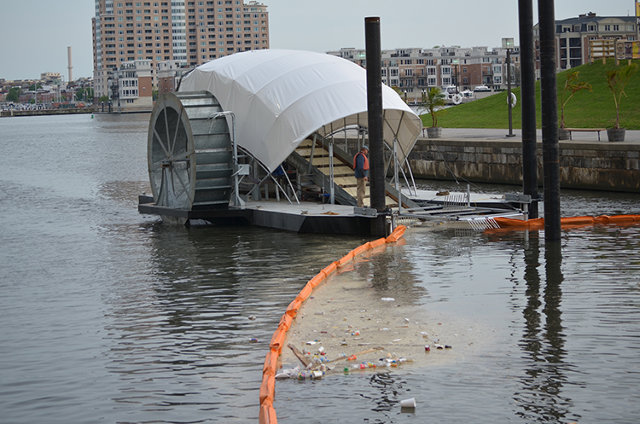Baltimore’s waterways are cleaned via a water wheel and the natural current. As the current rushes by, it turns the water wheel that collects up to 50,000 pounds of debris in waterways daily, an amount dependent upon the level of particulate matter in the water and the current of the water. Solutions such as this one are an excellent example of old technology being repurposed for the green virtuous function of cleaning up our rivers.
The water wheel won’t do anything about soluble chemicals or farm fertilizer run off, but can go a long way towards accomplishing the same thing that your once a year river clean up would otherwise. Furthermore, to compensate for fluctuations of river current, solar panels are there to provide the extra kick needed to keep the wheel turning.
While technology representing the most cutting edge science is most appealing to demonstrate that an information society can address the problems and challenges of our industrialized society trying to strike a balance with the biosphere, examples such as this water wheel demonstrate that information and technology alone will not solve our problems. Actions, not some new application or ‘likes’ on Facebook will accomplish the actual feats needed to bring our impacts into alignment with the capacity of the natural biosphere.
I particularly like this example as a showpiece of the urban infrastructure that could be a showpiece of waterfront parks in a downtown park setting. The inherent challenge to these types of solutions is whether or not individuals will assume these types of solutions merely enable their continued polluting and harmful activities to continue. My response, as a pragmatic philosopher, is that our ethics should dictate that we do not harm the environment, however there are always those that may not act ethically or situations of unintended or unforeseen outcomes, such as raccoons that tip over the garbage bin on a rainy night that washes away the refuse to the waterways. As a result, the water wheel is a means to address what might otherwise might pollute our waterways, and serves as a visual reminder that we need to act as stewards of our rivers.
Ideally, the real solution is one in which we don’t pollute the waterways in the first place… until that day becomes reality, I would love to see one of these in every city that is situated on a river.

Fifty-thousand pounds a day? That’s stunning.
50,000 is the claim… which is mostly dependent upon the current of the river way and the amount of debris in the water. The claim, I think, is more aimed at demonstrating the impact that the wheel can have on cleaning the water, however what is probably more important is the fact that the initial dumpster that was used to collect the water waste had to be replaced with a much larger one. I think what is really the most important part of the contraption is that it works and is passive in nature. I also highlighted this for the fact that it is repurposing what is basically old tech repurposed in a very clever manner. Thanks for the comment!!!
Ah, I see. That makes sense–and you did write “up to” 50,000 pounds. Thanks for the explanation 🙂